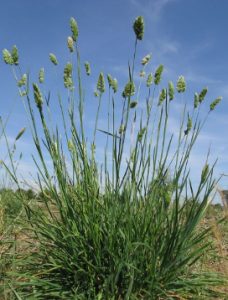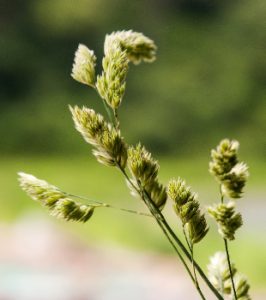Bulletin #2266, Maine Forage Facts: Orchardgrass
Bulletin #2266, Maine Forage Facts: Orchardgrass (PDF)
By Jaime Garzon, Assistant Extension Professor and Dairy Forage Educator, University of Maine Cooperative Extension
For information about UMaine Extension programs and resources, visit extension.umaine.edu.
Find more of our publications and books at extension.umaine.edu/publications/.
Orchardgrass
Orchardgrass (Dactylis glomerata L.) is a tall, cool-season grass that grows in clumps or bunches. The leaves are folded when young and often form a V-shaped trough, making the stems flat, but rounded when flowering. The seedhead is roughly triangular, 2 to 8 inches long, with seeds produced in bunches. Orchardgrass is especially well adapted for mixtures with legumes such as alfalfa or red clover. It will persist longer than the other cool-season grasses in frequently cut, adequately managed, alfalfa mixtures. Orchardgrass is a versatile grass for grazing, hay, green chop, or silage. It will provide excellent feed for most classes of livestock due to its great nutritive value. It is less winter hardy than timothy.
Orchardgrass is known as “cocksfoot” in Europe, New Zealand, and Australia. This name was derived from the shape of its seedhead.
Site selection
Orchardgrass requires well-drained, fertile soils. It also requires good surface drainage because it doesn’t tolerate winter icing. There have been many reports of winterkill in Maine on poorly or somewhat poorly drained soils. The optimum soil pH range is from 5.8 to 6.8.
Orchardgrass tolerates shade; its ability to grow under trees undoubtedly led to its common name. It is more tolerant of heat and drought than perennial ryegrass, timothy, or Kentucky bluegrass, but less than tall fescue.
Soil preparation and establishment
Orchardgrass is usually easy to establish in either early spring or late summer. Late summer seedings, however, could be most successful due to less weed competition, but appropriate soil moisture must be considered for successful germination. There is an increased risk of winter injury with summer seedings made after mid-August.
Seeding rate is 10 to 12 pounds per acre or 4 to 6 pounds per acre when seeding with legumes. Use 4 pounds for seeding with a slow-growing legume like birdsfoot trefoil, and a 6 pounds with a competitive legume like alfalfa. Orchardgrass should not be seeded with other grasses because of differences in maturity and palatability. There are approximately 645,000 orchardgrass seeds per pound.
Seeds must be planted at ¼ to ½ inch deep into a well-prepared seedbed. Successful seeding can be accomplished with band seeders, cultipack seeders, and grain drills. Increase 30% of the recommended seeding rate whether doing broadcast sowing. Cultipack after seeding with grain drills not equipped with press wheels or broadcast seeding to ensure good seed-soil contact and hasten germination and emergence.
If orchardgrass or mixtures are seeded with a small grain companion crop, removing the small grain at the boot stage minimizes competition with forage seedlings and increases the chances of obtaining a good orchardgrass stand.
Liming and fertilization
A soil test recommendation should direct any liming or fertilizer application. To get high yields, ensure soil nitrogen, phosphorous, and potassium are suitable for orchardgrass. Nitrogen should be applied to early spring growth and will probably be needed after each harvest.
If soil fertility is low, a large proportion of the total production of orchardgrass occurs in spring. In contrast, with proper fertility and nitrogen applications split, following harvests may contribute 35 to 65% of total production. By comparison, the aftermath of timothy, with similar management and fertility, contributes about 20% of the total yield. Annual nitrogen applications of 150 pounds per ac are accepted. However, overfertilization results in continued late fall growth and decreased winter hardiness.
In the absence of a soil test, nitrogen should be applied in split applications of 50 pounds per acre in early spring when the orchardgrass begins to green up and 50 pounds per acre after each cutting. Also, apply 40 to 60 pounds per of phosphate (P2O5) and 100 to 140 pounds per acre of potash (K2O) at seeding.
Varieties
Orchardgrass varieties are usually selected by improved yield, winter hardiness, and maturity date. Some varieties available in Maine markets are:
Olathe: An early bloom orchardgrass with high yielding, and good tolerance against diseases, heat, and stress. Ideal for grazing farms in southern climates. Olathe may be established via full cultivation, no-till, or broadcast seeding.
Inavale: This is a medium-late maturing leafy orchardgrass with strong disease resistance. Its summer heat tolerance makes it a great choice for grazing or hay. Inavale has good seedling vigor and establishes rapidly. In the transition zone, planting should occur in the late summer.
Echelon: Echelon is a very late-maturing, persistent orchardgrass with good fall productivity, excellent winter hardiness, and summer heat tolerance, making it an ideal choice for pasture grazing, hay production, and as a companion with alfalfa. Interplanting with alfalfa can improve stand yield, extend longevity, and reduce winterkill risks and pest damage associated with growing a pure stand.
Devour: Developed to tolerate more exigent grazing systems than other varieties. Quick to establish, out-competing weeds, and producing a better, high-yielding pasture. Late maturing can be seeded with clover or alfalfa. High digestibility and good palatability.
Productivity
For the highest nutritive value and high-yielding hay, orchardgrass should be harvested in spring during the boot stage. Beyond this stage, there is little increase in yield, but digestibility decreases by about 0.5% per day. Orchardgrass blooms in late May to early June in Maine. Aftermath growth can be harvested at 4 to 6 weeks intervals. Production and cutting frequency are greatly affected by soil moisture, temperature, fertility, and disease incidence. Yield varies from 2 to 5 tons of dry matter per acre per harvest.
It is essential a carefully stand management during the first year for long-term productivity. The height during the first year should ideally be maintained at 4 to 12 inches to produce a dense leafy stand. This allows full sunlight penetration to the plant base, which triggers the production of the tillers needed for maximum plant growth and spread. Once the seedlings are firmly rooted, graze lightly by calves, or machine mow several times before heavy use. This will promote further tillering and growth. Cold winter survival is enhanced by entering winter with the grass left at a short but still green 4 to 5 inches stubble height.
Orchardgrass blooms earlier than timothy, and regrowth and summer growth are better. Orchardgrass can be seeded alone or with a legume. Alfalfa is the preferred legume because both orchardgrass and alfalfa require good drainage, grow upright, are equally competitive when fertility is good, and regrow at a similar rate. Other legumes may not compete against orchardgrass.
Grazing management
Since orchardgrass is a high-quality grass, it can be grazed by most classes of livestock. Rotational grazing is usually preferred for the best production, persistence, and quality. Fields should be grazed heavily and frequently (every 12 to 15 days) during the flush growth of spring, but overgrazing should be avoided. Leave a 4 to 5 inches stubble height so the grass can recover quickly. Heavy grazing during October can lead to depleted root reserves and increased winter injury.
A three-year study at Purdue University compared animal performance when grazing orchardgrass and tall fescue. Both cows and calves gained approximately ½ pound per day more on orchardgrass than on tall fescue. The conception rate of the cows was 18% higher on the orchardgrass pastures. Although some tests have shown orchardgrass and tall fescue to give a similar animal performance, it is generally agreed that orchardgrass has greater nutritive value during spring and summer than fescue. This is probably associated with the endophyte problem in older tall fescue varieties. However, fescue has higher quality in fall, especially after frost.
References
Griffin TS, Coffin D. (2004). Forage facts: growing forage grasses in Maine (Report 2262). University of Maine Cooperative Extension. Orono (ME), United States.
Hall M. (2000). Orchardgrass. Pennsylvania State University Extension. University Park (PA), United States.
Hannaway D, Fransen S, Cropper J, Teel M, Chaney M, Griggs T, Halse R, Hart J, Cheeke P, Hansen D, Klinger R, Lane W. (1999). Orchardgrass. Oregon State University. Corvallis (OR), United States.
Henning J, Risner N. (1993). Orchardgrass. University of Missouri Extension. Columbia (MO), United States.
King’s Agriseeds Inc. Seed catalog. kingsagriseeds.com/
Seedway-Growmark Inc. Seed catalog.
Information in this publication is provided purely for educational purposes. No responsibility is assumed for any problems associated with the use of products or services mentioned. No endorsement of products or companies is intended, nor is criticism of unnamed products or companies implied.
© 2023
Call 800.287.0274 (in Maine), or 207.581.3188, for information on publications and program offerings from University of Maine Cooperative Extension, or visit extension.umaine.edu.
In complying with the letter and spirit of applicable laws and pursuing its own goals of diversity, the University of Maine System does not discriminate on the grounds of race, color, religion, sex, sexual orientation, transgender status, gender, gender identity or expression, ethnicity, national origin, citizenship status, familial status, ancestry, age, disability physical or mental, genetic information, or veterans or military status in employment, education, and all other programs and activities. The University provides reasonable accommodations to qualified individuals with disabilities upon request. The following person has been designated to handle inquiries regarding non-discrimination policies: Director of Equal Opportunity, 5713 Chadbourne Hall, Room 412, University of Maine, Orono, ME 04469-5713, 207.581.1226, TTY 711 (Maine Relay System).



